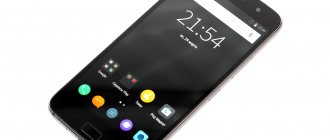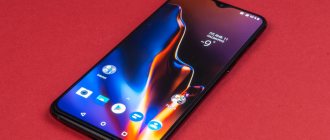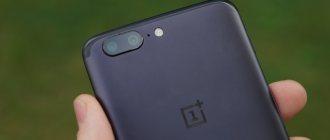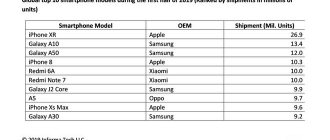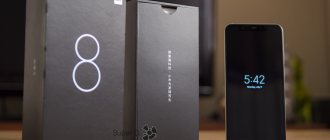Old friend for new money
OnePlus 7 is a complete copy of OnePlus 6T.
Even the scanner is the same. In contrast to colleagues from other sites, we will first deal with OnePlus 7. Regular, without the Pro index.
A very original device - an almost exact copy of last year's OnePlus 6T . The same body, the same shapes, the same screen with FullHD+ , the same technologies.
Even the battery capacity is the same 3700 mAh , not to mention the memory configuration.
The drop has become the most popular solution. But not the flagship, but the middle segment
In fact, there are 3 changes: Qualcomm Snapdragon 855 , UFS 3.0 and improved sensors of the dual main camera, which, like the previous version, received optical stabilization.
Bottom line: OnePlus 7 should actually be called “OnePlus 6TT” at a price slightly lower than at the start of sales of last year’s version.
This smartphone will be of interest primarily to current fans of 1+ who want to update the outdated “three” and “five”.
But will they do this when they are still very good?
Performance and tests
The heart of the OnePlus 7T is Qualcomm's most powerful processor to date - the Snapdragon 855 Plus. It is paired with an Adreno 640 GPU, 8GB of RAM and 128GB of UFS 3.0 internal storage. OnePlus' motto has long been 'fast and smooth', and it's no wonder the legacy continues. Oxygen OS is already quite minimalistic and streamlined, but it's the powerful components under the hood that make this device run incredibly smooth and fast.
The Snapdragon 855 Plus processor is currently only available in a few devices. This chip is clearly geared towards gaming, with a pretty significant 15% GPU boost over the 855. Considering OnePlus devices have long been considered gaming phones under the guise, this makes sense. Frankly, I'm impressed that OnePlus was able to offer us this chip at this price.
Another hardware option that provides fast performance is UFS 3.0 storage. The company first introduced a much faster memory option with the 7 Pro, and it's equally surprising that the feature made its way to a slightly more affordable device so quickly. I think 128 GB is quite enough for most users. Unfortunately, there is no option for expansion via microSD cards. Considering OnePlus only offers one specification for this phone, it's nice to see 8GB of RAM as well. The manufacturer has long been known for offering killer performance at a low price, and it continues to do so.
In tests, OnePlus 7T shows very good results. It scored 400,713 points in AnTuTu against 369,029 for the Samsung Galaxy Note 10 Plus. In 3DMark it scored 6163 and 5408, in OpenGL and Vulcan, compared to 5692 and 5239 on the Note 10 Plus. On Geekbench, I got scores of 3690 and 11452 for single-core and multi-core tests, compared to the Note 10 Plus's scores of 3434 and 10854. In Gary Speed Test G, the new 7 Pro finished the test in 1 minute 30 seconds, almost the same as the Galaxy Note Plus.
Top flagship with innovations
The older version of OnePlus 7 Pro received a simplified design and a complex design
OnePlus 7 Pro is the main leader of the new generation. Apart from the price, which, however, has never been OPPO's strong point, this is a real “flagship killer”.
So, what we have: the classic style of the latest OnePlus models and a lot of real differences from other Chinese devices.
The main achievement of the developers is a huge 6.67-inch diagonal AMOLED display with QuadHD+ . But more importantly, it has a 90Hz refresh rate and HDR10/HDR+ support .
Brightness of 800 nits is enough even in the desert and under the Arabian sun at its zenith!
The promos don't shine. But the filling is impressive
You won't find anything like this in Chinese smartphones. Neither Xiaomi, nor Asus, nor any other mid-range manufacturer has such displays.
The speed achieved with the Snap 855 and UFS 3.0 memory combo should exceed the results of other brands, but inferior to the younger version.
No less an achievement was the top combination of Sony's best sensors in the main camera. And isn’t the retractable front camera an innovation? (Looking ahead - no.)
Let's try to figure it out in more detail. Not everything is so simple.
Appearance of OnePlus 7
Van Plas 7 did not borrow the main feature in terms of design from vivo NEX and vivo V15 Pro. We are talking about a retractable front camera. The selfie camera is housed in a waterdrop notch at the top of the bezel.
OnePlus 7 has a large 6.41-inch screen with Full HD+ resolution. It's perfect for watching videos. Like models of previous generations, the company’s next flagship has a Super AMOLED panel with a built-in fingerprint scanner. You can buy Van Plus 7 in two traditional color options:
- black;
- golden;
- red;
- blue.
In all cases, the front side is made in black color. The back panel of the flagship is made of glass, but despite this, One Plus 7 does not have support for wireless charging. The company is confident that normal wired fast charging is much more necessary for modern smartphones.
At the back of the OnePlus 7 there are two camera modules in a vertical orientation. Other design features of the device include the absence of a headphone jack and a memory card slot, as well as the presence of a USB Type-C port and a proprietary Alert Slider switch.
How did OnePlus become the fastest?
Today, Snap 855 is the most powerful processor in terms of overall performance
Today, Snapdragon 855 has become the de facto standard for flagship devices. Even in the worst tests, its computing unit scores almost twice as many parrots as the previous 845 processor.
The result of the Adreno 640 is 40-50% better than its predecessor, which makes it the undisputed leader among all existing solutions.
Question: what to do with this colossal performance, if the mid-priced Snap 7xx can cope with any tasks, existing and future?
Neighbors are far behind in ratings. But how does it correspond to reality?
The power of flagships is excessive, and can only be useful to save battery. It is doubtful, however.
Another thing is memory, although 6/8/12 GB today also won’t surprise anyone (why is the last option needed?). But the OnePlus 7 (Pro) drive...
In some incomprehensible way, OPPO managed to get a sufficient amount of the fastest permanent memory UFS 3.0.
New memory standard shows twice the performance
This will really have a serious impact on performance: applications will launch at lightning speed, the system will work like a clock, photos will be instantly saved in memory - HDR series without interruptions will become a reality.
A real Chinese flagship, the fastest even in the basic version. It is a pity that UFS 3.0 is in short supply, which will lead to a natural supply shortage.
Comparison of OnePlus 7T specs with OnePlus 7 and 7 Pro
On September 26, the OnePlus brand presented OnePlus 7T - a continuation of the sub-flagship OnePlus 7, which was only four months old from the date of its announcement. Surprisingly, OnePlus 7T Pro was not shown at the presentation in India - this will probably happen on October 10 at an event in London.
Let's compare the technical characteristics and prices of the new product with OnePlus 7 and 7 Pro, and draw conclusions - is it worth upgrading to the improved “seven”?
Specifications of OnePlus 7T, OnePlus 7 and OnePlus 7 Pro:
| OnePlus 7T | OnePlus 7 | OnePlus 7 Pro | |
| Dimensions: | 160.94×74.44×8.13 mm, 190 g | 157.7×74.8×8.2 mm, 182 g | 162.6×75.9×8.8 mm, 206 g |
| Display: | 6.55”, 2400×1080 (~402 ppi, 20:9), Fluid AMOLED (90 Hz), Gorilla Glass, HDR10+ | 6.41”, 2340×1080 (~402 ppi, 19.5:9), Optic AMOLED, Gorilla Glass, HDR10 | 6.67”, 3120×1140 (~516 ppi, 19.5:9), Fluid AMOLED (90 Hz), Gorilla Glass, HDR10+ |
| CPU: | 8-core Qualcomm Snapdragon 855+, 2.96 GHz, Adreno 640 | 8-core Qualcomm Snapdragon 855, 2.84 GHz, Adreno 640 | 8-core Qualcomm Snapdragon 855, 2.84 GHz, Adreno 640 |
| Memory: | 8 GB RAM LPDDR4X, 128/256 GB permanent UFS 3.0 | 6/8 GB RAM LPDDR4X, 128/256 GB permanent UFS 3.0 | 6/8/12 GB RAM LPDDR4X, 128/256 GB permanent UFS 3.0 |
| Camera: | 48+12+16 MP, f/1.6+f/2.2+f/2.2 (main triple), 16 MP, f/2.0 (front) | 48+5 MP, f/1.7+f/2.4 (main dual), 16 MP, f/2.0 (front) | 48+8+16 MP, f/1.6+f/2.4+f/2.2 (main triple), 16 MP, f/2.0 (front) |
| Battery: | 3800 mAh, Warp Charge 30T | 3700 mAh, Warp Charge 20 | 4000 mAh, Warp Charge 30 |
| OS: | Android 10, OxygenOS | Android 10 (Android 9 at announcement), OxygenOS | Android 10 (Android 9 at announcement), OxygenOS |
| Connection: | USB 3.1 Type-C, Wi-Fi 802.11ac, Bluetooth 5.0, GPS, LTE, Dual SIM, NFC | USB 3.1 Type-C, Wi-Fi 802.11ac, Bluetooth 5.0, GPS, LTE, Dual SIM, NFC | USB 3.1 Type-C, Wi-Fi 802.11ac, Bluetooth 5.0, GPS, LTE, Dual SIM, NFC |
| Case colors: | Glacier Blue, Frosted Silver | Mirror Gray, Red (China and India only) | Mirror Gray, Nebula Blue, Almond |
It is OnePlus 7 and OnePlus 7T that are the main competitors of this trio. But they also have many differences. The latter adopted the Fluid Display concept from the flagship OnePlus 7 Pro, that is, a screen with a maximum frame rate of 90 Hz.
But that’s not all: the OnePlus 7 Pro also moved from a 16-megapixel wide-angle photo sensor with a 117-degree capture angle, support for HDR10+ technology, and a Haptic Vibration tactile feedback engine. Fast charging has become more powerful by 10 W, but OnePlus has also worked on thermal management and power management.
Of course, OnePlus 7T beats OnePlus 7 and even OnePlus 7 Pro in performance thanks to the Snapdragon 855+ processor. Graphics have been improved by 15%, CPU power has also increased. By the way, OnePlus 7T lost the 6 GB RAM option: we probably won’t get such a choice in the 7T Pro either.
The 7T also uses a 12-megapixel telephoto camera, but with only a twofold zoom, and the 7 Pro uses an 8-megapixel telephoto lens with a threefold zoom. But the experiment showed that the latter still physically has a 13 megapixel sensor, and the 5 megapixel gap is used for cropping, since the real optical zoom is slightly more than 2x. OnePlus 7 does not have a telesensor at all; the second sensor is used for portrait mode.
OnePlus has also added useful features to OxygenOS. “Gallery” now automatically distributes photos into smart albums and allows you to send pictures to the cloud (5 GB storage is free), there is a setting for “work” and “regular” smartphone profiles with applications disabled in one and enabled in the other, and other options, sorting incoming SMS into folders (“Promo”, “Personal”, “Purchases”, etc.). But all this will most likely appear on previous models.
Official prices of OnePlus 7T, OnePlus 7 and OnePlus 7 Pro at the time of announcement:
| OnePlus 7T | OnePlus 7 | OnePlus 7 Pro | |
| 6+128 GB | — | 32,999 rupees (~30,500 rubles) | 48,999 rupees (~44,600 rubles) |
| 8+128 GB | 37,999 rupees (~34,300 rubles) | — | — |
| 8+256 GB | 39,990 rupees (~36,000 rubles) | 37,999 rupees (~35,100 rubles) | 52,999 rupees (~48,400 rubles) |
| 12+256 GB | — | — | 57,999 rupees (~53,000 rubles) |
Translation of prices into rubles at the exchange rate as of September 27, 2019
As you can see, the OnePlus 7T has increased slightly in price compared to the OnePlus 7, while being much cheaper than even the younger version of the OnePlus 7 Pro. The latter has only two advantages left - frameless and large display diagonal (which for some may even be a minus). The +200 mAh battery in Pro is eaten up by the same screen.
At the same time, there is no point in upgrading to the 7T for current OnePlus 7 owners. The performance increase is imperceptible, 90 Hz is not worth it, except that the presence of a wide-angle sensor and a “telephoto” is an obvious plus for lovers of mobile photography.
But for those who are just looking at the current smartphones of the Chinese brand, you can forget about the regular “Seven” and choose between OnePlus 7T or 7 Pro. Unless, of course, the goal is to save money, because on foreign sites OnePlus 7 can be found for only 25-28 thousand rubles.
Are the cameras as good as DxO says?
Regular and Pro can only be distinguished by cameras
Another important innovation of the seventh generation of “flagship killers” was cameras.
Even the basic version is equipped with a very high-quality combination of a 48 megapixel Sony IMX586 (f/1.6) and an auxiliary unnamed 5 megapixel sensor for measuring the depth of field of an image.
Example shot on OnePlus 7 Pro #1. Impressive
Perhaps, for the average user this is the best option: there is no overpayment for numerous modes, but the system will allow you to take very good shots: bright, voluminous.
True, the front camera of the “seven” was inherited from last year’s device. The presence of optical stabilization is also not specified.
Example shot on OnePlus 7 Pro #2. The color and shadow transitions are great
The older model OnePlus 7 Pro set a kind of record DxO Previously, 1+ did not achieve such results.
The manufacturer equipped the smartphone with a triple main camera consisting of 48 MP Sony IMX586 (regular lens, f/1.8), 8 MP (telephoto lens, f/2.4) and 16 MP (wide-angle lens, f/2.2).
Example shot on OnePlus 7 Pro #3. Like a DSLR
In addition, the camera system supports three-level autofocus, 3x optical zoom and Nightscape 2.0 . Sounds great!
But again, not a word about optical stabilization. By the way, the closest competitor, Xiaomi Mi 9 , with a similar main camera, failed the test in real conditions, turning out to be worse than the used Mi 8.
A special chic is the retractable camera. But, alas, it is not unique: a similar mechanism has already been produced by A-brands, and today it can be found in the twin brothers OnePlus 7 Pro from Vivo and OPPO.
⇡#Design, ergonomics and software
Nothing special - briefly, the appearance of the OnePlus 7T can be described something like this. Smartphones released under this brand always looked good, were made of high-quality materials, but were not particularly original. OnePlus 7T is no exception - unlike the Pro version, it did not receive a retractable front camera, content with the usual but boring influx in the status bar area.
The frames around the large (6.55 inches), but still not as huge as the 7T Pro (6.67 inches), the display is very narrow - the developers even almost managed to get rid of the “chin” - but the smartphone still came out impressive dimensions It’s impossible to say that Pro is for lovers of large shapes, and the “regular” 7T is for connoisseurs of compactness. And this is a little strange: an obvious opportunity to differentiate the devices in terms of positioning and target audience was missed. In any case, you will have to use an almost two-hundred-gram device that hardly fits into your pocket.
OnePlus 7T, front panel: above the screen, which occupies almost the entire front panel, we see a slot with two speakers and a cutout with a front camera
Like the front panel, the back panel is covered with glass as usual - it is tempered Gorilla Glass 5, slightly beveled at the edges. The smartphone shimmers beautifully in the light, but it is very slippery, and the gadget is primarily in danger not when it is in your hand, but when it lies on any insufficiently level surface. The device tends to slip off it even from a static position - this happened to me once during testing, when it fell from about a meter high on the table. I must admit, the tempered glass passed this test; I did not find any visible damage on the OnePlus 7T. But you should immediately put some kind of protection on your smartphone, since a transparent silicone - and fairly decent quality - case is already included in the kit. The perimeter of the smartphone is edged with metal.
OnePlus 7T, rear panel: in the center is the main camera unit, consisting of three lenses and a dual LED flash
There are two color variations of the OnePlus 7T: Frosted Silver and Glacier Blue.
OnePlus 7T, left side: volume key/camera shutter key
OnePlus 7T, right side: smartphone lock/power key and sound profile switch
It should be noted that the OnePlus 7T, unlike the 7T Pro, has at least a conditional individuality when viewed from the back. The cameras here are not lined up in a vertical row, but are inscribed in a circle. Large and taking up a lot of space on the back panel, it nevertheless gives a certain recognition to the gadget - there are no other smartphones on the market with an identical solution to the “three camera problem”.
OnePlus 7T, top edge: additional microphone
OnePlus 7T, bottom edge: main speaker, USB Type-C port, microphone, slot for two nano-SIM cards
The layout is typical for OnePlus: the volume key is on the left side, while on the right, along with the lock/power button, we see a lever for switching sound profiles, which can be reconfigured to taste. Due to the location of the power key opposite the volume down button, during use you periodically accidentally take screenshots - about three per day. But this is a minor quibble. The mini-jack has disappeared from OnePlus smartphones, alas, completely - unless fashion takes a new turn, now in the analog direction.
Despite the lack of retractable parts, the OnePlus 7T, like the older model, lacks the declared water resistance, which is often presented as an example of the company’s honesty. At a minimum, the company's smartphones have had splash protection for a long time, but OnePlus does not indicate it, since it does not include cases of phone flooding in the warranty. Other companies that declare IP67 or IP68 standards for their gadgets also do not provide them with warranty service in such situations. However, it is officially OnePlus's gap compared to other flagship smartphones that needs to be mentioned.
The fingerprint scanner is located under the screen - it is an optical sensor that will not respond to the touch of a wet finger or attempts to unlock the smartphone in wet or snowy weather. If your finger is dry and the weather is good, everything will be fine - the scanner works well. If desired, you can supplement the fingerprint scanner with a facial recognition system. It’s simple here, it works only with the front camera, without additional sensors, this is an unreliable method - the company even blocked the ability to use it to confirm purchases and when using Google Pay, but it works very quickly, including in low light.
Screenshots of the Oxygen OS shell
View all images (30)OnePlus 7T runs Android 10 with the updated Oxygen OS shell of the tenth version. It has no serious differences from Oxygen 9.5, with which we tested the OnePlus 7 Pro: gestures when selecting gesture controls are now characteristic of Android, and not proprietary from OnePlus; “Zen mode”, which debuted on OnePlus 7, has become more flexible and has more settings; The system interface can also be quite flexibly customized to your liking. I should have stopped here, enjoying the almost pure Android with the only difference being the Never Settle service, which replaced the far left Google Now screen... but I unexpectedly didn’t like the way the OnePlus 7T works.
That is, in general, it works as usual quickly and smoothly, which is generally typical for smartphones with a flagship platform, a large amount of RAM and without a bulky shell - applications load quickly, the most resource-intensive games launch easily and do not slow down, everything seems to be fine. But every now and then the smartphone gets stuck - the browser freezes, requiring a reboot, or some random application like Instagram starts to glitch. This cannot be cured by rebooting the gadget; during two-week testing, it kept annoying me with minor problems, several times a day. This is definitely the most unstable OnePlus I've encountered. ( Editor's note : another copy of the same OnePlus 7T with the same firmware version - 10.0.7HD65AA - did not notice any problems.)
What tricks to expect from new OnePlus products
Absence of excess - that’s genius
The main problem with OnePlus smartphones lately is the discrepancy between reality and what is stated. Alas, this is confirmed in at least 3 latest devices of the sixth and fifth-sixth intermediate generations (T).
What will buyers encounter?
1. Performance: the company likes to increase the rating in Antutu.
2. Cameras: will the end buyer be able to realize its potential? Does it exist to the extent that the company promises?
Many people won't care how many times the camera fires. Not everyone uses it
Oddly enough, OnePlus 6 and 6T shot worse than the rather mediocre Xiaomi Mi 6 and 8 (compared to the iPhone and Samsung, of course). A repetition of the situation is all too real. Fans of the brand will definitely be waiting for detailed tests.
3. Other (traditional for OnePlus): “crude” firmware, weak speakers, quickly burning out batteries - all of them will be fixed within 3-5 months. But during this time the market will change.
4. Charging: WARP Charge is incredibly fast, but requires proprietary, branded chargers and cables that are as bankrupt as Apple's.
5. Under-screen scanner: still inferior to the regular one. Another stone in the garden, although all major new products of 2020 are guilty of it.
The under-screen scanner is beautiful, but it works so-so
One thing is for sure: if the developers have not made any serious mistakes, the autonomy of the OnePlus 7 Pro will be comparable to the regular version and significantly exceed the market average.
In addition, the sound of the maximum version is improved by additional additional amplifiers. And this is a very attractive feature today.
Xiaomi doesn’t hold it in high esteem, so year after year among the “Chinese” it is OnePlus that is worth recommending for consuming audio/video content.
Bottom line
The OnePlus 7T is one of the best devices OnePlus has created in recent years. The smartphone has the best specifications available on the market, the latest version of Android and an excellent camera system for the money.
Personally, I think the 7T puts the OnePlus 7 Pro in an even weirder position. The new device is cheaper, has better characteristics (weaker screen resolution and battery capacity). Sure, the 7 Pro offers a pop-up selfie camera, but the notch on this device really doesn't bother me.
Is it worth buying?
If you're looking for a new flagship smartphone, the OnePlus 7T is the best budget deal available today. If you want a headphone jack, incredible battery life, or an even higher resolution display, you might want to look elsewhere.
Advantages
- Price quality.
- New Android 10 OS.
- Super fast charging.
- Fantastic cameras.
- Wonderful interface.
- Gorgeous 90Hz display.
- High performance and speed.
Flaws
- No wireless charging.
- No headphone jack.
- There is no official IP rating.
- Average battery life.
More smartphones, more profits
The regular version has become too minor an option
The appearance of 2 versions of the new 1+ at once should alert fans. The last time the brand offered OnePlus X was back during the third version of the smartphone, later flatly refusing to design simpler models.
The reason was the complete failure of the X in sales - the difference in price with the main model was insignificant for the segment of alternative flagships 15-20%, or $100.
At the same time, the device lost a significant part of its corporate image, becoming the company's first non-metallic device. And now, after a deafening collapse, we again see the sub-flagship.
What's the matter?
The building has been updated. But it's barely noticeable
The “regular” OnePlus 7 is so similar to the sixth generation of “flagship killers” that it can be suspected of using last year’s components. And there is a certain amount of truth in this.
If you take a closer look at large retailers ( JD , AliExpress ), it becomes clear that not all devices intended for the Asian market have been sold.
The same thing is happening in the Russian sector, where OnePlus 6 and 6T are still on sale, and are not even going to get cheaper. Accordingly, there must be stocks of unused components somewhere.
Bad sign. But not for all markets.
Why OnePlus is waiting for failure in Russia
Even the basic modification is good. But Huawei is more affordable here
Brand sales are higher than ever in the American and European markets: OnePlus occupies the same place here as premium Huawei models in the CIS.
Apparently, the release of two variants should ensure an increase in sales primarily in the USA, including occupying the niche of Xiaomi, which is not selling very well there.
Russia and our neighboring countries are a completely different matter. Although the company's older models are very common, each new generation is greeted with increasing skepticism.
The reasons are few, but they are important: rising price, lousy local marketing, and well-known hardware and software problems.
The fate of Vivo NEX S is deplorable: the camera did not save an overly expensive smartphone
Therefore, they choose Xiaomi, and OnePlus is most often purchased at JD sales, where its price is reduced below the official one. We can assume that this brand is dead for us.
On the other hand, the seventh generation may well change the trend if it is not replaced by the already officially sold version of the device from Vivo with a different design.
And don’t forget that OnePlus in a different design is already available on the Russian market. Under other names.



